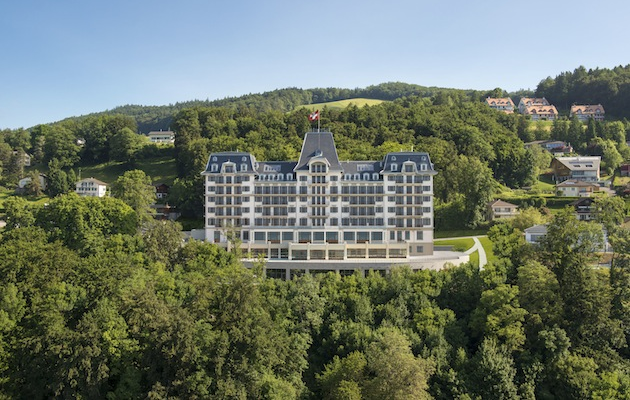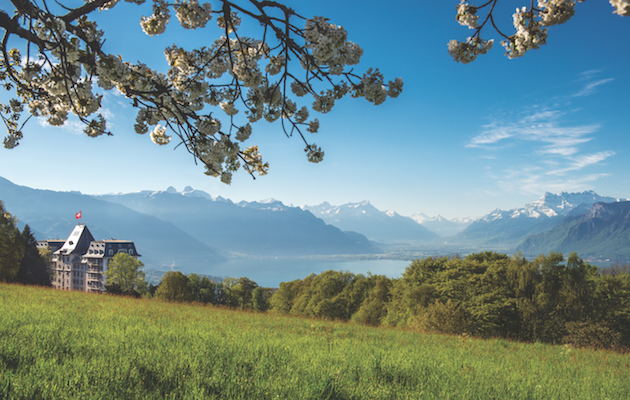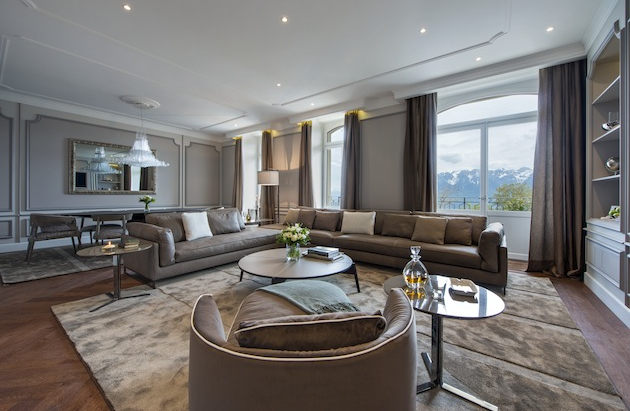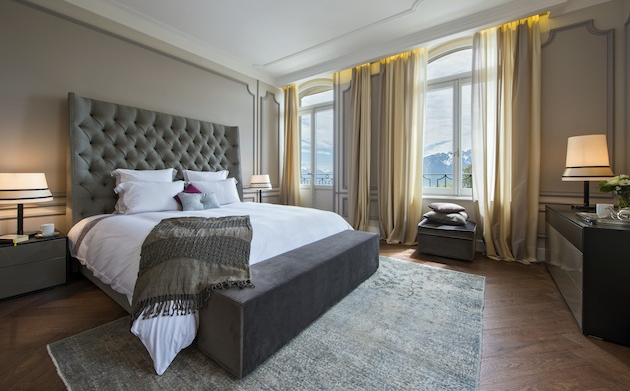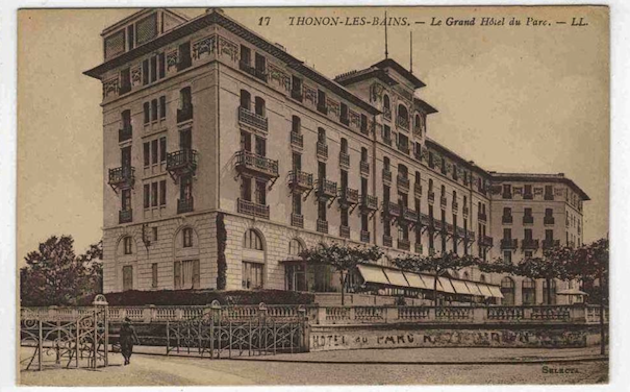Switzerland is a land where tranquility reigns as a disciplined and ordered affair. The mountains may run with the bounty of clean air, Alpine milk and the fruits therein (chocolate, healthy living in great gulpfuls and the lure of the slopes) but the beauty is of a sensible, wholesome kind, suited to the picture postcards of its heyday at the turn of the century as a haven for those seeking an idyllic lifestyle with no surprises. Therefore, in my extensive travels across the globe, Switzerland eluded me in favour of the wild allure of Italy or the familiar comfort of France, and I investigated most of her bordering lands without ever thinking of Lake Geneva or mountain delights.
My father spent much time in Geneva and would wax lyrical about wondrous water, clean streets and unrivalled security for ones family. He suggested that I spend some time there to think, in the calm and tranquil surroundings of classically approved beauty. But what did I care for such things in the heat of my twenties, with only passion and adventure as my guiding principles? Switzerland became a country easily and wrongly dismissed. Far better to while away the summers in Ibiza or Brazil, sitting on rocks facing the Atlantic ocean, filled with blazing sunsets and a sense of romanticism and bohemian values, which, in hindsight, seem rather naive.
The Swiss writer and philosopher Alain de Botton wrote a book called ‘On Love’, published when he was a mere fledgling of twenty-two. When I became pregnant with our first child my husband gave me this book as a gift and a quote from its pages seems pertinent to my position on Switzerland from the travelling days of my twenties, “Everyone returns us to a different sense of ourselves, for we become a little of who they think we are.”
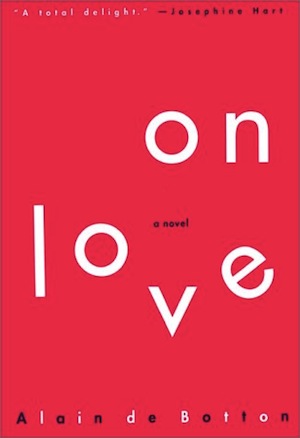 The ‘they’ referred to in this quote was surely my father, his words echoing from the past about the rather different woman who was emerging from a different place in her life. My father never knew me as this woman, he knew the wild child, not the woman happily in love, not the woman who was preparing to become a mother. I was, as Mr de Botton suggests, becoming the woman my father always thought I was underneath the bluster. As these internal changes were happening in my life, I was, a few months later, coincidentally invited to Switzerland to view Du Parc Kempinski Private Residences (I’m going to call them Du Parc) which were being built on the shores of Lake Geneva; twenty-two delicious apartments topped with a penthouse triplex, near the lake town of Vevey. Switzerland and I were to meet at last.
The ‘they’ referred to in this quote was surely my father, his words echoing from the past about the rather different woman who was emerging from a different place in her life. My father never knew me as this woman, he knew the wild child, not the woman happily in love, not the woman who was preparing to become a mother. I was, as Mr de Botton suggests, becoming the woman my father always thought I was underneath the bluster. As these internal changes were happening in my life, I was, a few months later, coincidentally invited to Switzerland to view Du Parc Kempinski Private Residences (I’m going to call them Du Parc) which were being built on the shores of Lake Geneva; twenty-two delicious apartments topped with a penthouse triplex, near the lake town of Vevey. Switzerland and I were to meet at last.
The history of the building caught my attention; a famous hotel, once frequented by the chicest of La Belle Epoque, it had an illustrious past and one which, at first impression, seemed more appealing than its present. Yet there was something in the pictures which were sent to me, some whisper of romance which appealed. I saw the photographs and I thought of my father, his loss still so recent, and remembered his words. Therefore, six months pregnant, I decided to go – even though I am usually found writing about music or the arts – arranged by one of the worthy editors of this tome. Well looked after and patiently catered for, for all the activities on offer, during the visit I was able only roll up and down the many hills of Switzerland, unable to participate in the activities on offer, and was even too tired to be entertained at Montreux Jazz Festival. I would have tried the patience of a saint. Here I was, matronly, big-bellied and betrothed, visiting the country of calm, as advised by my father all those years ago.
How my younger self would have laughed.
And laugh I did as I sat down to lunch with my hosts in a lakeside restaurant beside the Jet d’eau in Geneva at the beginning of the trip. All was sunny and calm and I was given a sheaf of verbal and practical information about the Swiss Development Group SA. Now, some of you may well be far more business minded than I am, so please forgive me if I am a little vague about some of the finer points of investments, property development funds and other such exciting ventures. I confess I am a novice so I will refer you to the information and contact details at the bottom of this page, should your appetite for property be whetted by my descriptive prose, and some much cleverer person than I will provide the answers to these pressing questions, leaving me to discuss the details which interest me the most.
First a little note on SDG and some of my initial impressions. SDG are a Swiss-owned and operated property development company, founded in 2007, specialising in the luxury five-star hotel and private residence sector, with a marked difference from other similar companies. SDG try to integrate their properties into local communities wherever possible, making the properties not only part of the local landscape, but part of the community, by sourcing local craftsmen, materials and advice and, in doing so, fostering a sense of good feeling locally around the construction of these developments. In a market (both home and abroad; Brooklyn anyone?) filled with aggressive expansion, ghastly high rises and what I feel is a complete lack of respect for community and local economy, this attitude towards development, luxury or otherwise, seems to be what should be the norm, rather than the exception, as in this case.
The construction crew (who have worked on projects as varied and interesting as Canary Wharf in London to bridge repair in San Francisco) joined hand-picked teams of experts from all over the world, in consultation with the local Cantons, providing an organic and seamless harmony between residents both new and old. Ecologically, SDG adhere to Swiss MINERGIE standards, which ensure that homes built with this mark are energy efficient and don’t beat the environment with boxing gloves each time you turn on a light. All these elements are surely vital forethoughts before even considering investments on this scale – at the time of writing prices of apartments begin at 6 million CHF, with the Penthouse leaving no change from 85 million CHF – but, on researching the matter, such forethought and integration with local communities from developers is not a given. I wish that SDG’s business model could be applied more often on large and small scale developments, offering more local economies a slice of the luxury pie.
But I am not an economist and most of all I felt that the ethos of the company aims to sell a home – albeit a second or third one in many circumstances – rather than an empty shell, offering those who can afford the asking price unrivalled standards of living.
Which leads me quite nicely to Du Parc herself; historic, beautiful and elegant. Although only a building site when I visited, matters have progressed beyond even my active imagination. Du Parc stands beside Lake Geneva, in the midst of the UNESCO protected vineyards of the Lavaux. Here all is peaceful, the tranquil view of the mountains uninterrupted by any cityscape; the backdrop, perfect skies of Derek Jarman blue. It’s easy to see how writers such as Victor Hugo, who once lived in the Lavaux, could have emerged from these dreamy surroundings filled with inspiration and bracing ideologies. There’s just something about the air of Switzerland, despite its landlocked position, that leaves your mind clear and thoughts sparkling. But the Lavaux is not isolated as many such locations often are; life in the form of people and entertainment are a short drive away. Vevey, the nearest town to Du Parc is idyllic, situated on the Lake and brimming with views of the Alps. Her bigger sister, Montreux, is home to the jazz festival and a rather lively nightlife, the streets jammed with sports cars and elegant folk promenading in the early evening.
SDG purchased Du Parc with the proviso that her status as a Swiss historic site was preserved. Careful planning has ensured that the panoramic foyer on the ground floor (complete with picture windows on the grandest scale, overlooking magnificent gardens) has been completely rejuvenated, retaining many of the original features, such as the beautiful curved staircase and wooden beams. Further restoration by carefully selected craftsmen, carpenters and joiners from all over the world have created a luxurious and bespoke interior specification which caters to the dearest wish of your most decadent afternoon interior design chimeras. Full length windows open onto Lake Geneva, with terraces which wrap around the building like an haute couture belt of al fresco pleasure. The facade of the building remains much as it was during La Belle Epoque, when the celebrities of the day flocked to enjoy the view and the beauty therein.
As I ambled past the newly plastered ceilings and crossed floors still not laid, the old hotel spoke of her past and the strange and influential voices who had once spoken so freely in the meeting rooms of Mont-Pèlerin. The very first gathering of the Mont-Pèlerin Society (which exclusively consisted of Nobel Prize winners) aimed to “facilitate an exchange of ideas between like-minded scholars in the hope of strengthening the principles and practice of a free society and to study the workings, virtues, and defects of market-oriented economic systems.” From this society the modern ‘think tank’ movement was born, encouraging scholarly active discussion without propaganda or public relations. Imagine eavesdropping on one of those historic conversations in the wood panelled smoking rooms, now offered a fitting modern equivalent in the Davidoff Cigar Lounge, where one can indulge in the deeply incorrect pleasure of smoking cigars, curated as carefully as the wine in the old vaults beneath the building. I suppose one could go on for hours about the luxuries available at Du Parc, from the five-star housekeeping provided by Kempinski Hotel Group to an on-site Rolls Royce, helicopter shuttle, the private Givency Spa and pool underneath the residences and an eye-watering level of in-home technology; but, for me, that would be beside the point. These are the tangible luxuries that one should expect at the prices mentioned.
What I find most intriguing and alluring about Du Parc and the restoration that has been carried out is the rich history and scope for imagination that the building offers the landscape of today. Care and attention has been paid to the smallest details, ensuring that these apartments become home, secure and loving. And now, after all these years, I can truly see the value in a place that offers security and the warm embrace of home and hearth. comfort and safety. It would be interesting to see SDG applying their rigorous quality controls and building ethos to smaller developments available to a wider range of buyers, but for the moment Du Parc is the dream, a castle in the sky, composed not only of luxury that one can buy, but of words and memories from the past and the sweetest dreams of future generations. A place anyone would want to raise their family in, surrounded by the utmost beauty and tranquility, where well-being, order in a world filled with uncertainty and peace of mind are the ultimate balm, the ultimate luxury.
My father was right.
For more information about the Swiss Development Group SA, its properties, news updates and contact details, visit the website.
For enquiries about properties at DuParcKempinski Residences, contact the SDG Geneva offices, 20 Rue Philippe-Plantamour, 1201 Genève, Switzerland, email info@sdg.ch or by phone: +41 (0) 22 545 03 00.

